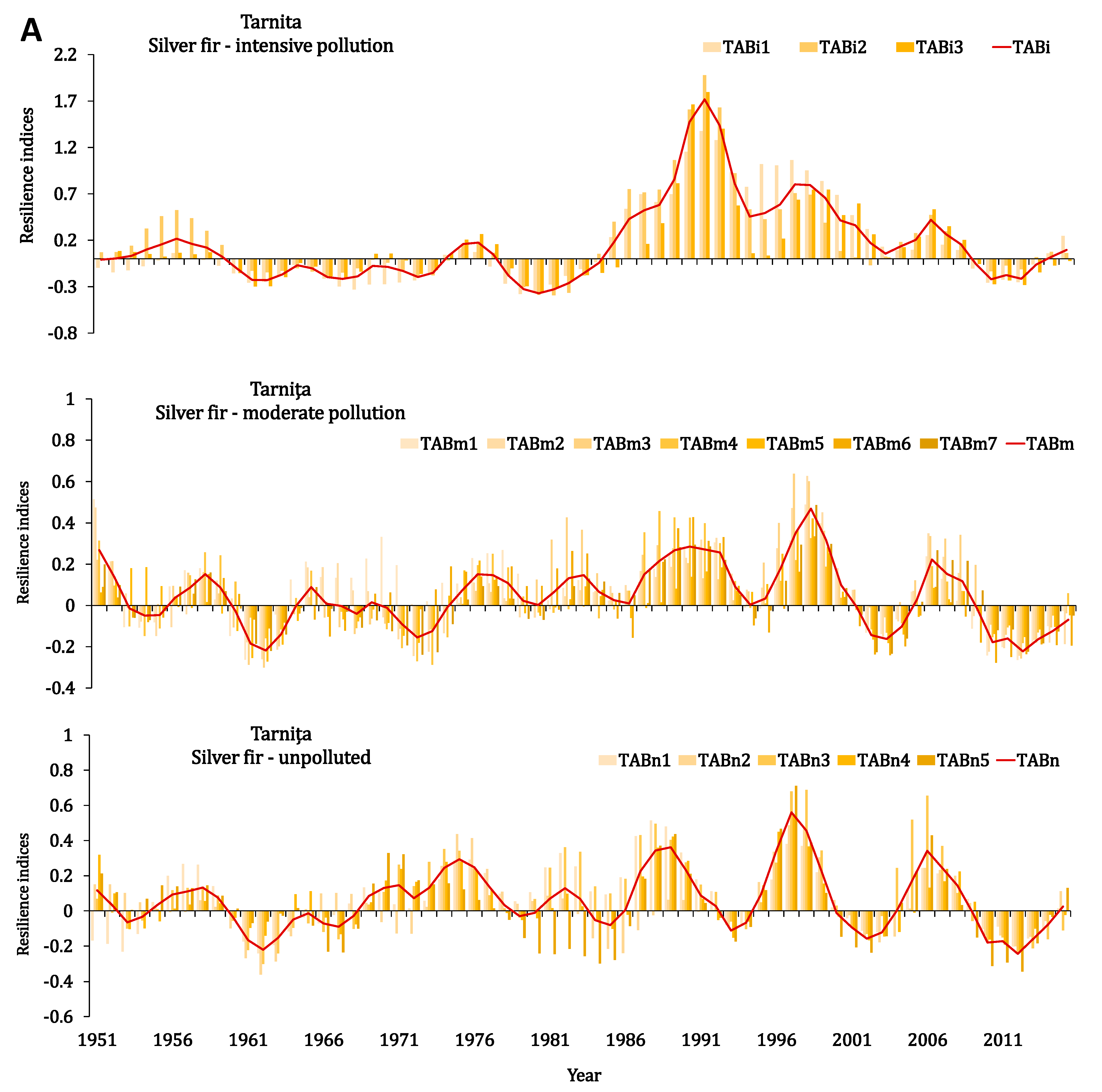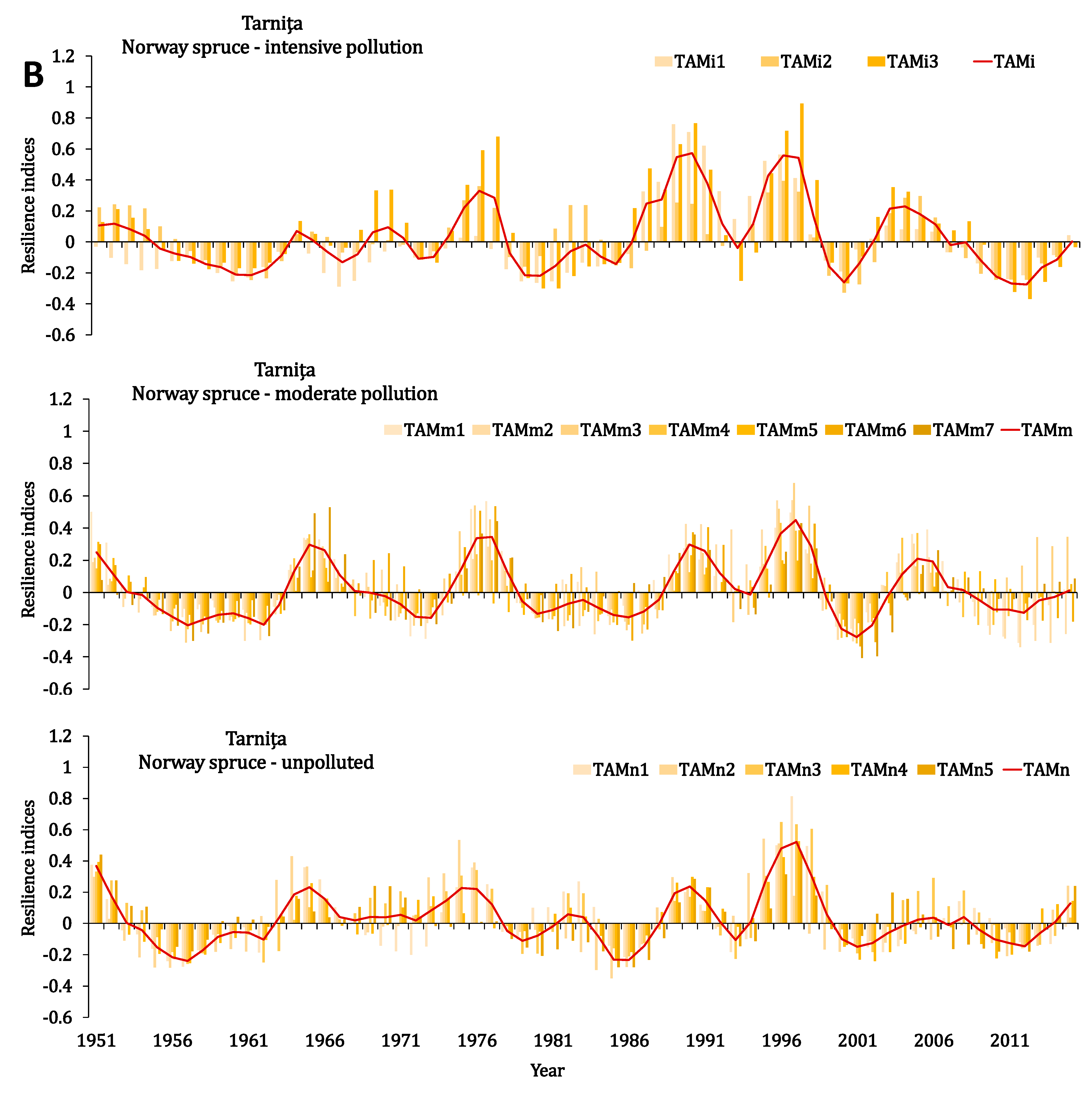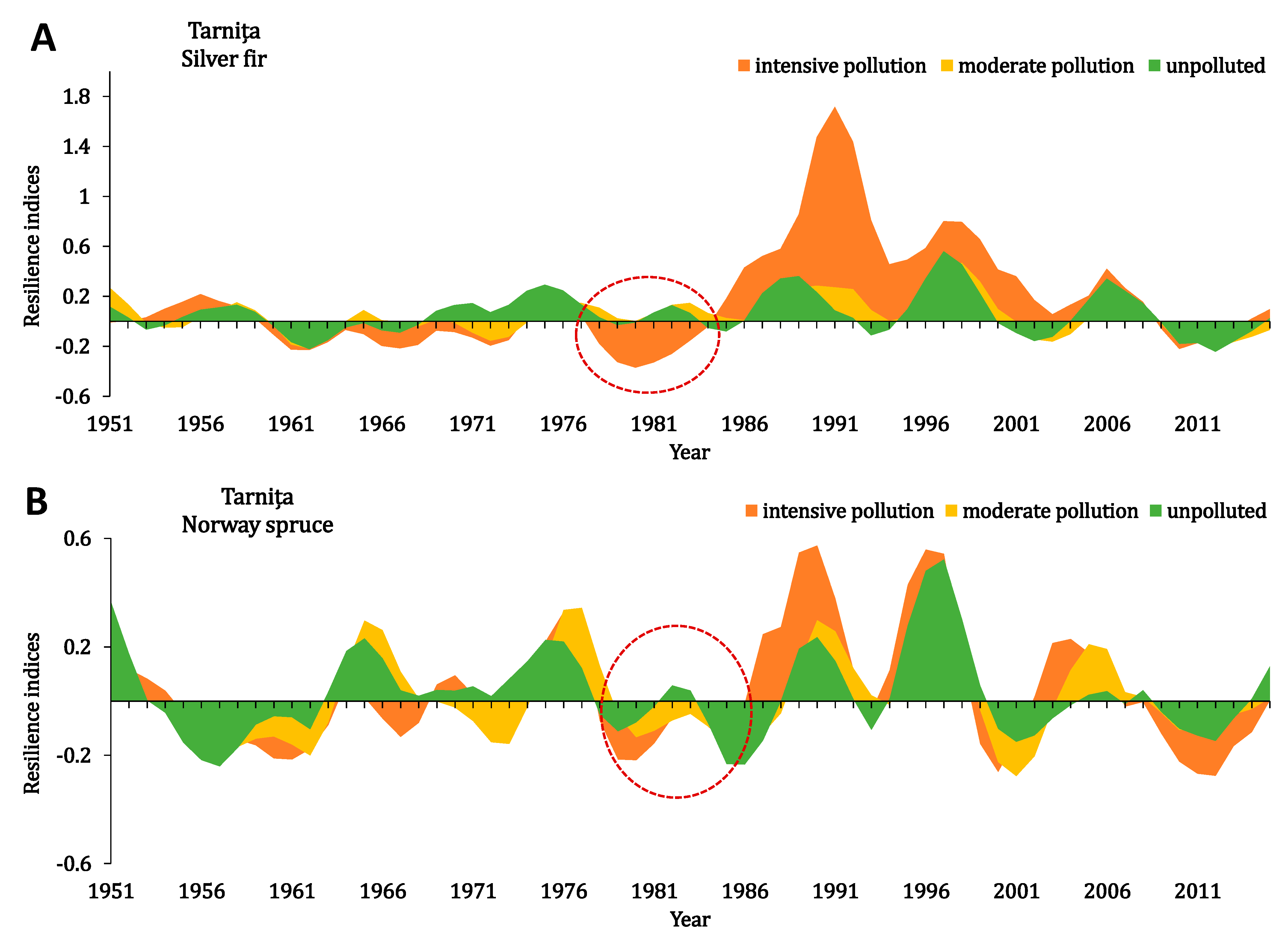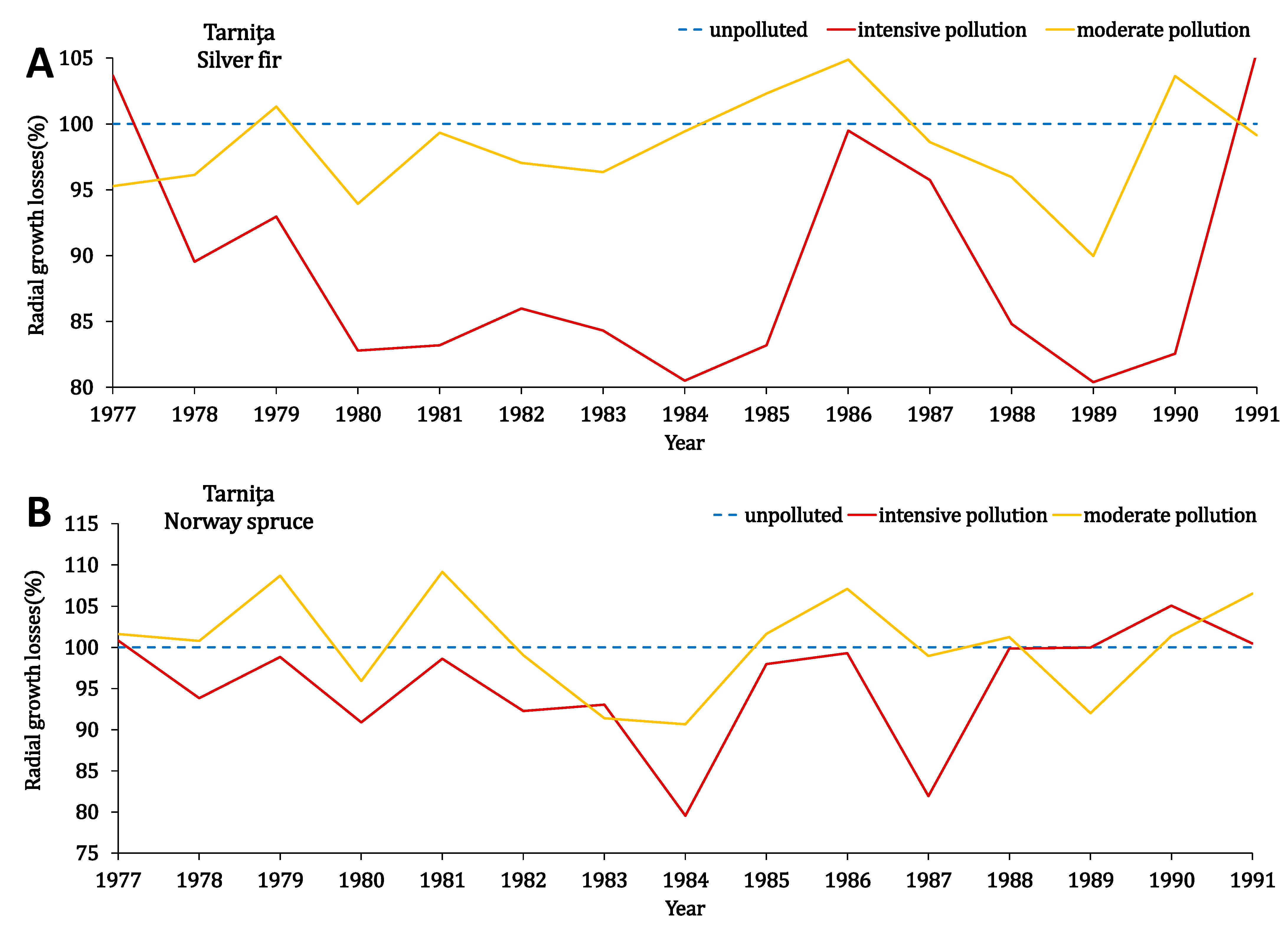Impact of Industrial Pollution on Radial Growth of Conifers in a Former Mining Area in the Eastern Carpathians (Northern Romania)
Abstract
:1. Introduction
2. Materials and Methods
3. Results
3.1. The Statistical Parameters of the Series of Average Radial Growth
3.2. Analysis of Growth Changes of Trees
4. Discussion
5. Conclusions
Author Contributions
Funding
Acknowledgments
Conflicts of Interest
References
- Elling, W.; Dittmar, C.; Pfaffelmoser, K.; Rötzer, T. Dendroecological assessment of the complex causes of decline and recovery of the growth of silver fir (Abies alba Mill.) in Southern Germany. For. Ecol. Manag. 2009, 257, 1175–1187. [Google Scholar] [CrossRef]
- Vallero, D. Fundamentals of Air Pollution, 5th ed.; Elsevier Academic Press: Oxford, UK, 2014; p. 996. [Google Scholar]
- Szaro, R.C.; Oszlanyi, J.; Godzik, B.; Bytnerowicz, A. (Eds.) Effects of Air Pollution on Forest Health and Biodiversity in Forests of the Carpathian Mountains; NATO Science Series 345; IOS Press: Amsterdam, The Netherlands, 2002; pp. 23–96. [Google Scholar]
- Shparyk, Y.S.; Parpan, V.I. Heavy metal pollution and forest health in the Ukrainian Carpathians. Environ. Pollut. 2004, 130, 55–63. [Google Scholar] [CrossRef] [PubMed]
- Staszewski, T.; Łukasik, W.; Kubiesa, P. Contamination of Polish national parks with heavy metals. Environ. Monit. Assess. 2012, 184, 4597–4608. [Google Scholar] [CrossRef] [PubMed]
- Dharani, N.; Onyari, J.M.; Maina, D.M.; Mavuti, K.M. The distribution of Cu and Pb levels in soils and Acacia xanthophloea Benth. From Lake Nakuru national park Kenya. Environ. Contam. Tox. 2007, 79, 172–177. [Google Scholar] [CrossRef] [PubMed]
- Truby, P. Impact of heavy metals on forest trees from mining areas. In Proceedings of the Sudbury Mining and the Environment Conference, Sudbury, ON, Canada, 25–28 May 2003. [Google Scholar]
- Král, J.; Vacek, S.; Vacek, Z.; Putalová, T.; Bulušek, D.; Štefančík, I. Structure, development and health status of spruce forests affected by air pollution in the western Krkonoše Mts. in 1979–2014. Lesn. Cas. For. J. 2015, 61, 175–187. [Google Scholar] [CrossRef]
- Mazurek, M.; Kowalska, J.; Gąsiorek, M.; Zadrożny, P.; Józefowska, A.; Zaleski, T.; Kępka, W.; Tymczuk, M.; Orłowska, K. Assessment of heavy metals contamination in surface layers of Roztocze National Park forest soils (SE Poland) by indices of pollution. Chemosphere 2017, 168, 839–850. [Google Scholar] [CrossRef]
- Muzikaa, R.M.; Guyettea, R.P.; Zielonkab, T.; Liebholdc, A.M. The influence of O3, NO2 and SO2 on growth of Picea abies and Fagus sylvatica in the Carpathian Mountains. Environ. Pollut. 2004, 130, 65–71. [Google Scholar] [CrossRef] [PubMed]
- Bytnerowicz, A.; Badea, O.; Popescu, F.; Musselman, R.; Tanase, M.; Barbu, I.; Vasile, C. Air pollution, precipitation chemistry and forest health in the Retezat Mountains, Southern Carpathians, Romania. Environ. Pollut. 2005, 137, 546–567. [Google Scholar] [CrossRef] [PubMed]
- Silaghi, D.; Badea, O.; Iacoban, C.; Neagu, Ș.; Leca, Ș. Air pollutants concentrations (O3, NO2 and NH3) registered in selected forest ecosystems (core plots) in the Romanian Intensive Monitoring Network (Level II). Rev. Pădurilor 2011, 126, 85–92. [Google Scholar]
- Salemaa, M.; Vanha-Majamaa, I.; Derome, J. Understorey vegetation along a heavy-metal pollution gradient in SW Finland. Environ. Pollut. 2001, 112, 339–350. [Google Scholar] [CrossRef]
- Leșan, M. Poluarea pădurilor din vecinătatea municipiului Baia Mare și consecințele ei asupra acumulării de masă lemnoasă. Rev. Pădurilor 2003, 118, 12–14. [Google Scholar]
- Stancu, P.T. Studii Geochimice şi Transformări Mineralogice Rezultate în Urma Proceselor Secundare de Exploatare Minieră Şi tehnologii de Remediere a Zonelor Poluate cu Metale Grele şi/sau Rare în zona Zlatna (Geochemical Studies and Mineralogical Transformations Resulting from Secondary Mining Processes and Technologies for Remediation of Areas Polluted with Heavy and/or Rare Metals in the Zlatna Area). Ph.D. Thesis, Bucharest University, Faculty of Geology and Geophysics, Bucharest, Romania, 2013. [Google Scholar]
- Ianculescu, M.; Budu, E.C. Indicatori biochimici de evaluare a rezistenței speciilor forestiere la poluarea industrială cu compuși ai sulfului în acțiune sinergică cu metalele grele în zona Copșa Mică (Biochemical indicators for assessing the resistance of forest species to industrial pollution with sulfur compounds in synergistic action with heavy metals in the Copșa Mică area). An. ICAS 2007, 50, 99–119. [Google Scholar]
- Vasile, D.; Bolea, V. Compararea calităţii aerului din Parcul Naţional Piatra Craiului cu alte Parcuri Naturale şi Naţionale din ţară (Air quality of Parcul Naţional Piatra Craiului compared with another Naturals and Nationals Parks of our country). Rev. Silvic. Cinegetică 2009, 25, 31–34. [Google Scholar]
- Flocea, N.M. Cercetări Auxologice în Păduri de Molid din Nordul Țării Aflate în zone Afectate de Poluare (Auxological Research in the Northern Spruce Forests of Romania Located in Areas Affected by Pollution). Ph.D. Thesis, Ștefan cel Mare University, Suceava, Romania, 2013. [Google Scholar]
- Jacoban, C.; Risca, I.M.; Roibu, C.; Ciorna, E.T.; Necula, R.; Ilieva, D.; Sandu, I.; Drochioiu, G. Tarnita Polluted Area: Accumulation of Heavy Metals and Nutrients from the Soil by Woody Species. Rev. Chim. 2019, 70, 753–758. [Google Scholar] [CrossRef]
- Ianculescu, M.; Ionescu, M.; Lucaci, D.; Neagu, S.; Măcărescu, C.M. Dynamic of pollutants concentration in forests stands from Copșa Mică industrial area. Ann. For. Res. 2009, 52, 207–226. [Google Scholar]
- Fritts, H.C. Tree Rings and Climate; Elsevier Academic Press: London, NY, USA, 1976; 567p. [Google Scholar]
- Schweingruber, F.H. Tree Rings and Environment-Dendrochronology; Haupt: Bern, Switzerland, 1996; 609p. [Google Scholar]
- Tilman, D.; Downing, J.A. Biodiversity and stability in grasslands. Nature 1994, 367, 363–365. [Google Scholar] [CrossRef]
- Cybis Elektronik: CDendro and CooRecorder. 2016. Available online: https://www.cybis.se/forfun/dendro/index.htm (accessed on 22 November 2020).
- Rinntech. Tsap User Reference; Triwerk GmbH & Co. KG Hardtstr: Heidelberg, Germany, 2005; 110p. [Google Scholar]
- Holmes, R.L. Computer-assisted quality control in tree-ring dating and measurement. Tree Ring Bull. 1983, 43, 69–75. [Google Scholar]
- Cook, E.R.; Kairiukstis, L.A. (Eds.) Methods of Dendrochronology. Applications in the Environmental Sciences; Kluwer Academic Publishers: Dordrecht, The Netherlands, 1990; 394p. [Google Scholar]
- R Core Team. R: A Language and Environment for Statistical Computing; R Foundation for Statistical Computing: Vienna, Austria, 2017; Available online: https://www.R-project.org (accessed on 20 October 2020).
- Popa, I.; Barbu, I. Evaluarea gradului de vătămare a ecosistemelor forestiere din zona Tarnița prin tehnici GIS de analiză spațială. Rev. Pădurilor 2001, 6, 8–11. [Google Scholar]
- Schwarz, J.; Skiadaresis, G.; Kohler, M.; Kunz, J.; Schnabel, F.; Vitali, V.; Bauhus, J. Quantifying Growth Responses of Trees to Drought–a Critique of Commonly Used Resilience Indices and Recommendations for Future Studies. Curr. For. Rep. 2020, 6, 185–200. [Google Scholar] [CrossRef]
- Chojnacka-Ożga, L.; Ożga, W. Impact of air pollution on Scots pine stands growing in Poland on the basis of dendrochronological analysis. Environ. Sci. Proc. 2021, 3, 77. [Google Scholar] [CrossRef]
- Godek, M.; Sobik, M.; Błaś, M.; Polkowska, Z.; Owczarek, P.; Bokwa, A. Tree rings as an indicator of atmospheric pollutant deposition to subalpine spruce forests in the Sudetes (Southern Poland). Atmos. Res. 2015, 151, 259–268. [Google Scholar] [CrossRef]
- Hauck, M.; Zimmermann, J.; Jacob, M.; Dulamsuren, C.; Bade, C.; Ahrends, B.; Leuschner, C. Rapid recovery of stem increment in Norway spruce at reduced SO2 levels in the Harz Mountains, Germany. Environ. Pollut. 2012, 164, 132–141. [Google Scholar] [CrossRef] [PubMed]
- Mihaljevič, M.; Ettler, V.; Šebek, O.; Sracek, O.; Kříbek, B.; Kyncl, T.; Majer, V.; Veselovský, F. Lead Isotopic and Metallic Pollution Record in Tree Rings from the Copperbelt Mining–Smelting Area, Zambia. Water Air Soil Pollut. 2011, 216, 657–668. [Google Scholar] [CrossRef]
- Hojdová, M.; Navrátil, T.; Rohovec, J.; Žák, K.; Vaněk, A.; Chrastný, V.; Bače, R.; Svoboda, M. Changes in Mercury Deposition in a Mining and Smelting Region as Recorded in Tree Rings. Water Air Soil Pollut. 2011, 216, 73–82. [Google Scholar] [CrossRef]
- Ianculescu, M.; Tisesscu, A. Efectele poluării industriale pe bază de compuși ai sulfului în acțiune sinergică cu metalele grele asupra creșterii arboretelor din zona Copșa Mică și evaluarea pagubelor produse (The effects of industrial pollution based on sulfur compounds in synergistic action with heavy metals on the growth of stands in the Copșa Mică area and the assessment of the damages caused). Rev. Pădurilor 1989, 104, 170–175. [Google Scholar]
- Ianculescu, M.; Bândiu, C.; Budu, C.E. Modificări ale principalelor procese-ecofiziologice la arborii forestieri ca urmare a influenței poluării în zona Copșa Mică (Changes of the main ecophysiological processes in forest trees due to the influence of pollution in the Copșa Mică area). Rev. Pădurilor 1989, 104, 64–68. [Google Scholar]
- Adamu, C.I.; Nganje, T.N.; Aniekan, E. Heavy metal contamination and health risk assessment associated with abandoned barite mines in Cross River State, southeastern Nigeria. Environ. Nanotechnol. Monit. Manag. 2015, 3, 10–21. [Google Scholar] [CrossRef] [Green Version]






| Forest Management Unit (u.a.) | Yield Management Unit (UP) | Distance from the Polluting Source (km) | Area (ha) | Age | Composition * | Exposure | Slope (Centesimal Degrees) | Altitude (m) | Canopy Cover | Yield Class | Standing Volume (m3/ha−1) |
|---|---|---|---|---|---|---|---|---|---|---|---|
| 73C | V Tarnița | 6.0 | 4.90 | 95 | 9MO1BR | NE | 28 | 1120 | 0.8 | 2 | 585 |
| 62A | V Tarnița | 3.1 | 6.34 | 105 | 4MO3BR2FA1PAM | NE | 25 | 985 | 0.7 | 2 | 416 |
| 39A | V Tarnița | 0.5 | 4.13 | 85 | 8MO2FA | NE | 16 | 860 | 0.4 | 2 | 304 |
| 111E | V Tarnița | 1.2 | 4.67 | 105 | 4MO4BR 2FA | SE | 26 | 980 | 0.6 | 3 | 396 |
| 118A | V Tarnița | 2.5 | 18.45 | 140 | 4MO4FA2BR | S | 26 | 1125 | 0.5 | 3 | 314 |
| 18F | V Tarnița | 3.2 | 19.54 | 140 | 5MO3FA2BR | NW | 36 | 1125 | 0.6 | 3 | 370 |
| 14C | V Tarnița | 1.6 | 6.87 | 95 | 5BR3FA2MO | S | 26 | 900 | 0.7 | 3 | 402 |
| 126I | V Tarnița | 1.2 | 5.2 | 100 | 6MO2BR 2FA | SE | 16 | 875 | 0.6 | 2 | 346 |
| 5A | VI Botoșana | 4.5 | 29.84 | 95 | 7MO2BR1FA | N | 27 | 905 | 0.7 | 1 | 572 |
| 17B | VI Botoșana | 3.1 | 10.66 | 75 | 8MO2BR | N | 18 | 1000 | 0.8 | 2 | 589 |
| 45A | VI Botoșana | 6.9 | 8.57 | 115 | 6MO2BR2FA | N | 18 | 775 | 0.7 | 2 | 601 |
| 61A | VI Botoșana | 6.0 | 16.22 | 110 | 4MO3FA2BR1PAM | SE | 22 | 1000 | 0.7 | 2 | 482 |
| 43B | IV Porcăreț | 6.2 | 24.2 | 95 | 6MO3BR1FA | NE | 24 | 990 | 0.7 | 2 | 513 |
| 22A | II Negrileasa | 9.7 | 28.78 | 95 | 5MO4BR1FA | N | 22 | 850 | 0.7 | 2 | 560 |
| 4B | VIII Gemenea | 12.0 | 18.10 | 110 | 8MO2BR | NW | 12 | 825 | 0.6 | 2 | 482 |
| 101C | VIII Gemenea | 12.1 | 13.03 | 125 | 8BR2MO | SW | 33 | 740 | 0.6 | 2 | 474 |
| Serial Code | No. of Cores | Overlapping Period > 10 Cores | Average Radial Growth | Average Sensitivity | Average Rbar | Location (FD/UP/u.a.) |
|---|---|---|---|---|---|---|
| TABi1 | 43 | 1943–2018 | 3.205 | 0.231 | 0.411 | Stulpicani/V/126I |
| TABi2 | 40 | 1925–2018 | 2.881 | 0.236 | 0.311 | Stulpicani/V/39A |
| TABi3 | 40 | 1861–2018 | 1.704 | 0.253 | 0.374 | Stulpicani/V/14C |
| TABm1 | 41 | 1922–2018 | 3.104 | 0.216 | 0.219 | Stulpicani/V/62A |
| TABm2 | 40 | 1930–2018 | 2.912 | 0.198 | 0.291 | Stulpicani/V/18F |
| TABm3 | 41 | 1921–2018 | 2.686 | 0.211 | 0.280 | Stulpicani/VI/5A |
| TABm4 | 43 | 1879–2018 | 2.409 | 0.209 | 0.234 | Stulpicani/V/118B |
| TABm5 | 40 | 1927–2018 | 2.729 | 0.185 | 0.237 | Stulpicani/VI/17B |
| TABm6 | 42 | 1896–2018 | 2.041 | 0.193 | 0.322 | Stulpicani/V/73C |
| TABm7 | 41 | 1895–2018 | 2.578 | 0.226 | 0.275 | Stulpicani/VI/61A |
| TABn1 | 40 | 1912–2018 | 2.882 | 0.195 | 0.256 | Stulpicani/VI/45A |
| TABn2 | 40 | 1893–2018 | 2.301 | 0.203 | 0.343 | Stulpicani/IV/43B |
| TABn3 | 40 | 1905–2018 | 2.632 | 0.228 | 0.319 | Stulpicani/II/22A |
| TABn4 | 40 | 1919–2018 | 2.765 | 0.196 | 0.238 | Stulpicani/VIII/4B |
| TABn5 | 40 | 1911–2018 | 3.346 | 0.216 | 0.390 | Stulpicani/VIII/101A |
| TAMi1 | 43 | 1946–2018 | 3.447 | 0.221 | 0.313 | Stulpicani/V/126I |
| TAMi2 | 40 | 1935–2018 | 2.993 | 0.210 | 0.304 | Stulpicani/V/39A |
| TAMi3 | 41 | 1907–2018 | 1.872 | 0.297 | 0.314 | Stulpicani/V/14C |
| TAMm1 | 40 | 1920–2018 | 2.738 | 0.228 | 0.209 | Stulpicani/V/62A |
| TAMm2 | 40 | 1926–2018 | 2.473 | 0.198 | 0.397 | Stulpicani/V/18F |
| TAMm3 | 40 | 1918–2018 | 2.463 | 0.217 | 0.306 | Stulpicani/VI/5A |
| TAMm4 | 42 | 1891–2018 | 2.303 | 0.204 | 0.304 | Stulpicani/V/118B |
| TAMm5 | 41 | 1938–2018 | 3.108 | 0.177 | 0.194 | Stulpicani/VI/17B |
| TAMm6 | 42 | 1891–2018 | 1.812 | 0.193 | 0.311 | Stulpicani/V/73C |
| TAMm7 | 40 | 1916–2018 | 2.680 | 0.213 | 0.365 | Stulpicani/VI/61A |
| TAMn1 | 40 | 1909–2018 | 2.657 | 0.224 | 0.322 | Stulpicani/VI/45A |
| TAMn2 | 41 | 1893–2018 | 2.201 | 0.210 | 0.248 | Stulpicani/IV/43B |
| TAMn3 | 40 | 1901–2018 | 2.357 | 0.270 | 0.364 | Stulpicani/II/22A |
| TAMn4 | 40 | 1915–2018 | 2.075 | 0.219 | 0.282 | Stulpicani/VIII/4B |
| TAMn5 | 42 | 1875–2018 | 2.361 | 0.228 | 0.237 | Stulpicani/VIII/101C |
Publisher’s Note: MDPI stays neutral with regard to jurisdictional claims in published maps and institutional affiliations. |
© 2021 by the authors. Licensee MDPI, Basel, Switzerland. This article is an open access article distributed under the terms and conditions of the Creative Commons Attribution (CC BY) license (https://creativecommons.org/licenses/by/4.0/).
Share and Cite
Sidor, C.G.; Vlad, R.; Popa, I.; Semeniuc, A.; Apostol, E.; Badea, O. Impact of Industrial Pollution on Radial Growth of Conifers in a Former Mining Area in the Eastern Carpathians (Northern Romania). Forests 2021, 12, 640. https://doi.org/10.3390/f12050640
Sidor CG, Vlad R, Popa I, Semeniuc A, Apostol E, Badea O. Impact of Industrial Pollution on Radial Growth of Conifers in a Former Mining Area in the Eastern Carpathians (Northern Romania). Forests. 2021; 12(5):640. https://doi.org/10.3390/f12050640
Chicago/Turabian StyleSidor, Cristian Gheorghe, Radu Vlad, Ionel Popa, Anca Semeniuc, Ecaterina Apostol, and Ovidiu Badea. 2021. "Impact of Industrial Pollution on Radial Growth of Conifers in a Former Mining Area in the Eastern Carpathians (Northern Romania)" Forests 12, no. 5: 640. https://doi.org/10.3390/f12050640






